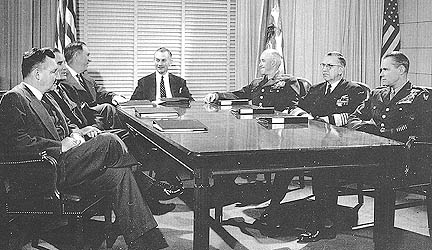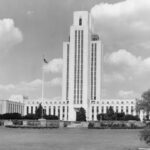The MJ-12 Documents
If the Government found evidence of Extra-Terrestrial Intelligence, would they tell the public? Or would they create a small compartmentalized group of key individuals in order to study the phenomena while keeping it an absolute TOP SECRET? The “Majestic 12” Documents are perhaps the most significant Government documents ever leaked to the public. Skeptics have long argued for documented proof of a UFO/ET cover-up on behalf of the Government, yet when provided with this evidence they deny and make excuses for it… I guess that it’s just easier than dealing with documented facts and evidence…The Founding Members of MJ-12
All the alleged original members of MJ-12 were notable for their military, government, and/or scientific achievements and all were deceased when the documents first surfaced (the last to die was Jerome Hunsaker, only a few months before the MJ-12 papers first appeared).
The original composition was six civilians (mostly scientists), and six high-ranking military officers, two from each major military service. Three (Souers, Vandenberg, and Hillenkoetter) had been the first three heads of central intelligence. The Moore/Shandera documents did not make clear who was the director of MJ-12, or if there was any organizational hierarchy.
The named members of MJ-12 were:
- Rear Adm. Roscoe H. Hillenkoetter: first CIA director
- Dr. Vannevar Bush: chaired wartime Office of Scientific Research and Development and predecessor National Defense Research Committee; set up and chaired postwar Joint Research and Development Board (JRDB) and then the Research and Development Board (RDB); chaired NACA; President of Carnegie Institute, Washington D.C.
- James Forrestal: Secretary of the Navy; first Secretary of Defense (replaced after his death on MJ-12 by Gen. Walter Bedell Smith, 2nd CIA director)
- Gen. Nathan Twining: headed Air Materiel Command at Wright-Patterson AFB; Air Force Chief of Staff (1953–1957); Chairman of Joint Chiefs of Staff (1957–1961)
- Gen. Hoyt Vandenberg: Directed Central Intelligence Group (1946–1947); Air Force Chief of Staff (1948–1953)
- Gen. Robert M. Montague: Guided missile expert; 1947 commander of Fort Bliss; headed nuclear Armed Forces Special Weapons Center, Sandia Base
- Dr. Jerome Hunsaker: Aeronautical engineer, MIT; chaired NACA after Bush
- Rear Adm. Sidney Souers: first director of Central Intelligence Group, first executive secretary of National Security Council (NSC)
- Gordon Gray: Secretary of the Army; intelligence and national security expert; CIA psychological strategy board (1951–1953); Chairman of NSC 5412 Committee (1954–1958); National Security Advisor (1958–1961)
- Dr. Donald Menzel: Astronomer, Harvard; cryptologist during war; security consultant to CIA and NSA
- Dr. Detlev Bronk: Medical physicist; aviation physiologist; chair, National Academy of Sciences, National Research Council; president Johns Hopkins & Rockefeller University
- Dr. Lloyd Berkner: Physicist; radio expert; executive secretary of Bush’s JRDB
Much respect to Stanton Friedman and UFO TV for putting this together!
Bethesda Naval Hospital
National Security Act (December 1947)
The National Security Act of 1947 (Pub. L. No. 235, 80 Cong., 61 Stat. 496, 50 U.S.C. ch.15) was signed by United States President Harry S. Truman on July 26, 1947, and realigned and reorganized the U.S. Armed Forces, foreign policy, and Intelligence Community apparatus in the aftermath of World War II. The majority of the provisions of the Act took effect on September 18, 1947, the day after the Senate confirmed James Forrestal as the first Secretary of Defense. His power was extremely limited and it was difficult for him to exercise the authority to make his office effective. This was later changed in the amendment to the act in 1949, creating what was to be the Department of Defense.[1]
The Act merged the Department of War and the Department of the Navy into the National Military Establishment, headed by the Secretary of Defense. It was also responsible for the creation of a separate Department of the Air Force from the existing Army Air Forces. Initially, each of the three service secretaries maintained quasi-cabinet status, but the act was amended on August 10, 1949, to assure their subordination to the Secretary of Defense. At the same time, the NME was renamed as the Department of Defense. The purpose was to unify the Army, Navy, and what was soon to become the Air Force into a federated structure. [2]
President Truman signed the National Security Act of 1947 onboard this VC-54C Presidential transport, the first aircraft used for the role of Air Force One. (At the time it was not painted with “U.S. Air Force” because it belonged to the USAAF.)
Aside from the military reorganization, the act established the National Security Council, a central place of coordination for national security policy in the executive branch, and the Central Intelligence Agency, the U.S.’s first peacetime intelligence agency. The function of the council was to advise the president on domestic, foreign, and military policies so that they may cooperate more tightly and efficiently. Departments in the government were encouraged to voice their opinions to the council in order to make a more sound decision.[3]
The Joint Chiefs of Staff was officially established under Title II, Section 211 of the original National Security Act of 1947 before Sections 209–214 of Title II were repealed by the law enacting Title 10 and Title 32, United States Code (Act of August 10, 1956, 70A Stat. 676) to replace them.
The act and its changes, along with the Truman Doctrine and the Marshall Plan, were major components of the Truman administration’s Cold War strategy.
The bill signing took place aboard Truman’s VC-54C presidential aircraft Sacred Cow, the first aircraft used for the role of Air Force One.[4]
Research References
- ^ Kinnard, Douglas. “The Secretary of Defense in Retrospect.” The Secretary of Defense. Lexington: University of Kentucky, 1980. 192-93. Print.
- ^ Cambone, Stephen A. “The National Security Act of 1947– 26 July 1947.” A New Structure for National Security Policy Planning. Washington, D.C.: CSIS, 1998. 228-32. Print.
- ^ Cambone, Stephen A. “The National Security Act of 1947– 26 July 1947.” A New Structure for National Security Policy Planning. Washington, D.C.: CSIS, 1998. 228-32. Print.
- ^ Fact Sheets : National Security Act of 1947 : National Security Act of 1947





